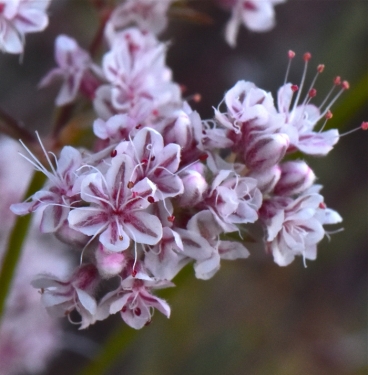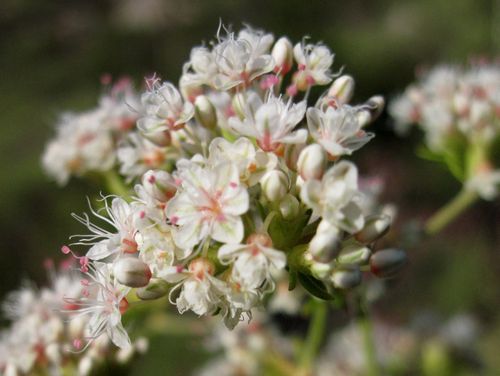California Buckwheat (Eriogonum fasciculatum) Known by the common name California buckwheat. This common shrub is native to the southwestern United States and northwestern Mexico, where it grows on scrubby slopes and in chaparral and dry washes in a number of habitats. It is variable in appearance, forming a patchy, compact bramble or a spreading bush approaching two meters in height and three across. The leaves grow in clusters at nodes along the branches and are leathery, woolly on the undersides, and rolled under along the edges. Flowers appear in dense, frilly clusters which may be anywhere from a few millimeters to 15 centimeters wide. Each individual flower is pink and white and only a few millimeters across. This plant is particularly attractive to honey bees and is a good source of nectar over many months in drier areas.
There are four recognized varieties of California Buckwheat: 1. Eriogonum fasciculatum var. foliolosum or Leafy California Buckwheat, a brighter green variety which grows primarily on the coast and western side of the coastal mountain ranges, and is often carried in nurseries, 2. Eriogonum fasciculatum var. polifolium, a gray variety which grows primarily in the desert regions and through the coastal foothills, and is sometimes available in nurseries, 3. Eriogonum fasciculatum var. fasciculatum, or Coastal California Buckwheat, which grows most closely to the coast, and 4. Eriogonum fasciculatum var. flavoviride, or Sonoran Desert California Buckwheat, which grows primarily in the Sonoran Desert and desert mountains.
California Buckwheats are tough and easy to grow, even in very dry conditions. Plant in a well draining sunny site. It shouldn't need supplemental water after established, but it will tolerate occasional summer water better than most extremely drought tolerant California natives. Form is variable, ranging from often open and upright in the foothills, to often dense and mounding closer to the coast. It produces profuse pink to white and cream-colored flowers as early as March that dry to a pretty red rust color as the soil dries. It sheds its dried flowers and a significant portion of its small blade-like leaves each dry season, and is an important plant for creating natural mulch. California Buckwheat is a keystone species for sagebrush scrub ecosystems, and a great choice for wildlife and butterfly gardens. Low growing forms of both Leafy Green Buckwheat and Interior California Buckwheat can be found in nurseries to use as spreading ground covers. Eriogonum fasciculatum 'Theodore Payne' can grow low as just 1 foot with a spread of up to 8 feet.Plant Description
Plant TypePlant Type
Perennial herb, Shrub
SizeSize
1 - 6.6 ft tall
3 ft wide
Flowering SeasonFlowering Season
Summer, Spring, Fall
Wildlife Supported
Bees, Butterflies
Bee gardens Bird gardens Butterfly gardens Butterfly host plants
Butterflies & moths hosted ( 15 confirmed , 36 likely * ) SHOW ALL
Common uses
Bank Stabilization, Bee Gardens, Bird Gardens, Butterfly Gardens, Deer Resistant, Groundcovers
Companion Plants
Many companions including Brittlebush (Encelia species), Sagebrush (Artemisia species), Sage (Salvia species), Manzanita (Arctostaphylos species), Ceanothus species, Yucca species, Dudleya species, and cactus species
Site Type
Dry slopes, often south facing as a common component of Coastal Sage Scrub. Inland it may be found in Valley Grassland. In high desert areas it occurs in Sagebrush Scrub and Pinyon-Juniper Woodland. It sometimes occurs in low desert areas as part of Creosote Bush Scrub
Climate
Annual Precipitation: 2.7" - 50.6", Summer Precipitation: 0.14" - 3.86", Coldest Month: 23.5" - 61.4", Hottest Month: 43.2" - 88.8", Humidity: 0.43" - 42.79", Elevation: 0" - 11630"

Common Names: Eastern Mojave Buckwheat, Flattop Buckwheat, Yellow Buckwheat
